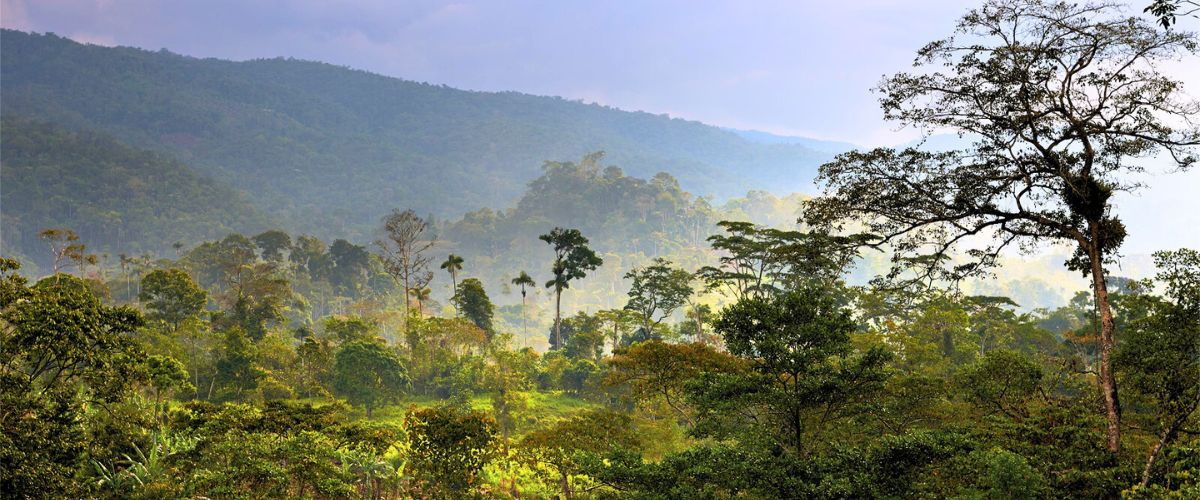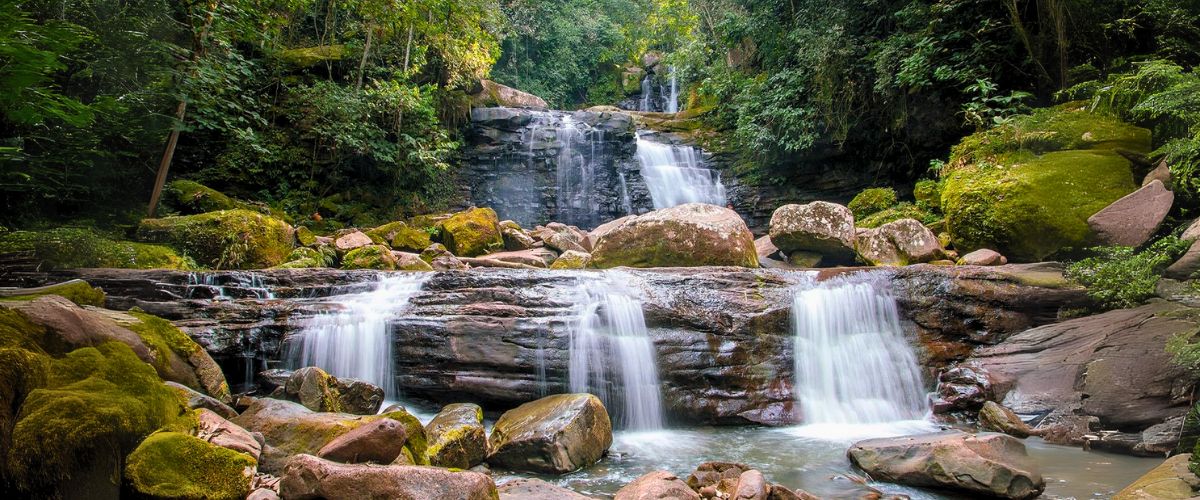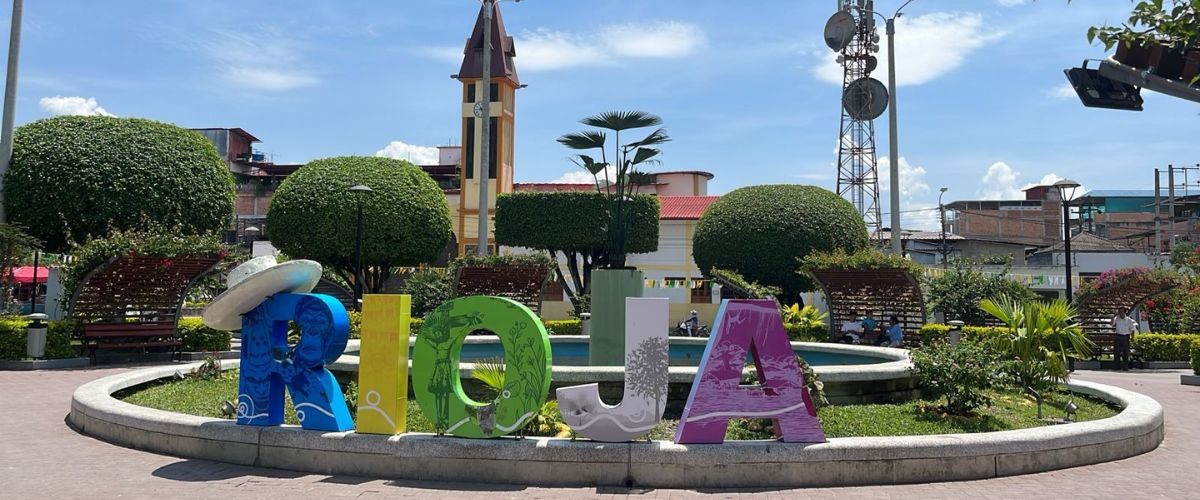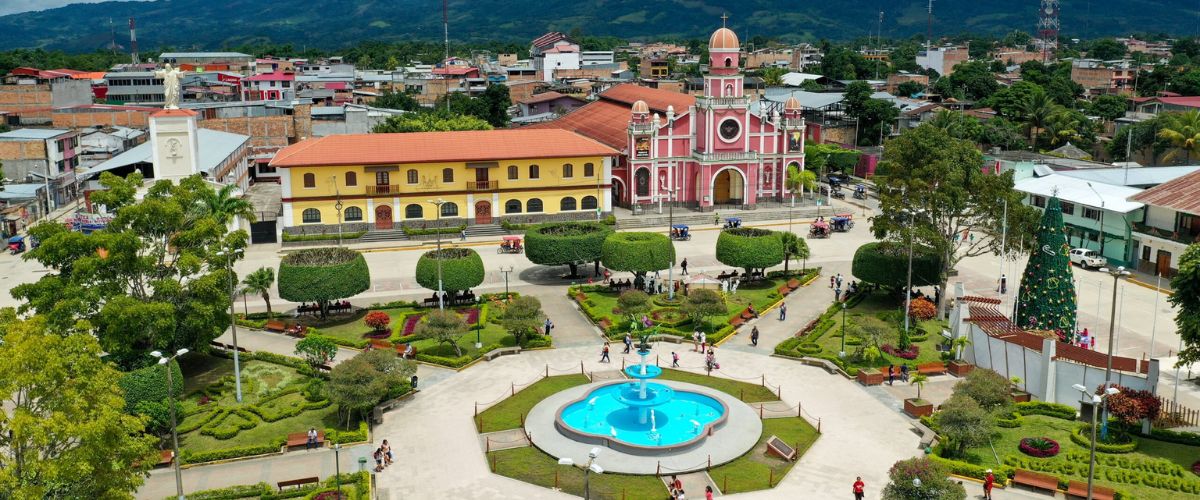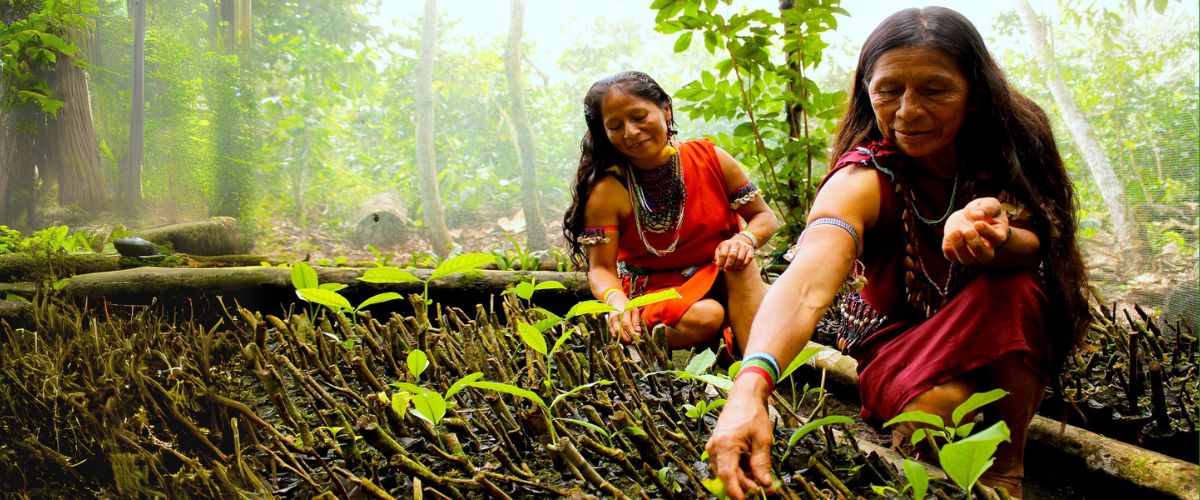To travel to Alto Mayo is to enjoy its extensive valleys through which rivers, ravines and streams run that make up abundant waterfalls and sandy beaches where you can cool off, underground caves to explore, and natural sources of thermal and sulfurous waters with healing properties.
Alto Mayo is an authentic natural jewel for being the destination with the most native bird species in Peru. In this way, the Alto Mayo Protected Forest becomes a paradise for bird watchers or birdwatchers, where the record for the largest number of species observed in one day was broken on Global Big Day 2014.
Some of the most representative birds of Alto Mayo are the Cock of the Rock (Peruvian national bird), more than 15 varieties of hummingbirds, toucans, parrots, among others.
In addition, the forests of Alto Mayo are home to nearly a thousand species of orchids, many of them endemic. For this reason, in honor of this ecological wealth, every year at the end of October the "Orchid Festival" is celebrated in the city of Moyobamba.
Alto Mayo is also the perfect destination to experience community tourism. Authentic and captivating experiences that will allow you to get to know different and alternative tourist routes, managed by the rural inhabitants themselves.
Visit Alto Mayo and learn about different species of Amazonian orchids and medicinal plants with the women of the indigenous community of Shampuyacu, enjoy harvesting your own honey from native bees, and savor one of the flagship products of this land, organic coffee, grown in the cloudy and fertile forests of this destination.
Located to the north of the San Martín region, the presence of exuberant mountain jungle forests in Alto Mayo invites you to enjoy a very pleasant temperate tropical climate, with temperatures that vary from 18 to 26ºC.
Discover one of the most complete destinations in the San Martín region, where you can find nature, culture, wellness, rural community tourism, as well as tourism specialized in bird watching and Amazonian orchids.
The Alto Mayo destination awaits you!
Location
Includes the provinces of Moyobamba and Rioja (San Martín Region, Peru).
Weather
The weather is very wet, with temperatures between 14 and 19 degrees Celsius. You can visit the BPAM any time of the year, but the best times to see birds are between 6:00 a.m. and 11:00 a.m. The season with less rain is from May to October.
How to get to Alto Mayo?
You can go from the Belaunde Highway, but it's better to fly to Tarapoto and then take a taxi or public transport to kilometer 382 of the Chiclayo - Tarapoto highway. After going through the town of Aguas Verdes, you enter the Alto Mayo Protection Forest (BPAM).
Another way from Tarapoto is to take a vehicle from the "Turismo Selva SA" company, which has routes to Chachapoyas or Bagua. You also get off at kilometer 382 to enter the sanctuary.
If you start from Moyobamba, you can take a shared taxi from the "Evangelio Poder de Dios" line, which also goes to Chachapoyas, with the same stop at kilometer 382.
These public transport services run about every three hours, between 8:00 a.m. and 6:00 p.m.
About The Alto Mayo Protection Forest (BPAM)
This place protects the Rainy Mountain Forests in the Northeast of Peru. It is in the Rioja and Moyobamba provinces, in the San Martín region. It was made in 1987 and covers 182,000 hectares. A big part of its land is hills covered with lots of plants, with heights between 900 and 3,400 meters, in a wet and rainy place. It has places like grasslands, dwarf forests, cloud forests, and premontane forests. It has big areas of old forest, known for its many different living things and beautiful views.
In this area, there are special animals like the Andean bear, the yellow-tailed woolly monkey, the jaguar, and the dwarf deer. Also, its forests keep hundreds of types of orchids and other plants that grow on trees, making it special.
The only road that goes through it is the Fernando Belaunde highway, letting people go in to explore and see its natural wonders.
Points of interest:
- Thermal baths of San Mateo
- Oromina Sulfur Baths and Asnacyacu Waterfall
- The Forest of the Nuwas
- Tingana Ecological Reserve
- Source of the Tioyacu River
- Morro de Calzada
- palestinian cave
- Cities and towns of destination Lamas
- Moyobamba
- Rioja
- Healthy Community Miguel Grau
What to visit in Alto Mayo?
Discover tourist places of your interest and build your own route:
Paccha waterfalls
The Paccha Waterfalls are a spectacle of nature made up of several waterfalls, coming from the ravine that bears the same name, which run over rocky beds, in the green shade of the Alto Mayo forest.
The Paccha Waterfalls are located in the district of Jepelacio, in the high jungle of the San Martín region, and its crystal clear water falls, where the warmth of the sunlight is reflected, pleasantly incite us to feel its energy in a bath. revitalizing.
To reach the Cascadas de Paccha, a harmonious walk is undertaken between rocky hills, accompanied by the symphonic song of the river, where it is very common to observe different types of colorful birds.
Among the birds that inhabit, we find the highly prized Cock of the Rock or tunqui (Rupícola peruviana), for the incredible beauty of its plumage, considered the national bird of Peru, and which can be seen in the treetops along the way. leading to the waterfalls.
Do not miss the opportunity to appreciate the Cock of the Rock, which in the early hours of the day, the males make their traditional nuptial display, characterized by intense screeches and their strange dance, in which they bend their heads forward and raise their wings . A spectacle of nature!
Once at the waterfalls and surrounded by a paradisiacal environment, you will be able to feel the refreshing enveloping breeze, emanated by the infinite rain of the Paccha waterfalls, the same ones that calm and mitigate our trip.
The privileged environment that surrounds the place, has beautiful and multiple songs of birds, leafy and tall trees, medicinal plants and a completely vast biodiversity in landscape richness, which make your senses stimulate and enjoy an environment of peace.
The Paccha waterfalls have four waterfalls, but at present, only the first 3 are accessible, such as: Paccha, El Salto del Alcalde and Los Helechos, fully equipped for visitors, and whose average heights reach thirty meters.
The fourth and last waterfall, called Peña de Horeb, is only recommended for those who like adventure, as its access is a bit more rugged and it is not adapted for all the public.
In the waterfalls you can have fun and swim in its various sources and pools of natural water, as well as splash in the middle of the aroma that emanates from the exotic flowers that are found both on the slope of the waterfall and around the pool.
For the most curious, the exotic flowers that can be distinguished are, mainly, different types of orchids and bromeliads, both species of flora endemic to the place.
The tourist attraction, managed by the Municipality of Jepelacio, has infrastructure in good condition, with a space at the reception to park your vehicle, toilets for ladies and gentlemen, rest tambos, hammocks and a restaurant with à la carte dishes.
Some of the dishes that you can taste in this place, when you return from your visit to the Paccha waterfalls and with an open appetite, are the guinea pig with potato, the chicken broth, the tacacho with cecina or patacones, the chicken stew or chicken mechado, among others.
You can also take the opportunity to buy some souvenirs for your loved ones in its souvenir shop, where you can find personalized poles, cold ceramic orchids, among others.
Near the Paccha waterfalls you can also count on two rest tambos, a safe bridge to cross the river and a well-conditioned stone path.
If you are looking for a place to reconnect with nature near the city of Moyobamba, the Paccha Waterfalls are the perfect destination for your family visit, and live a 100% natural experience.
How to get?
To visit the Paccha Waterfalls, we will drive along the paved road, from the city of Moyobamba to the district of Jepelacio, passing through the entrance to the thermal baths of San Mateo.
Once in Jepelacio, we will continue along the same road, but this time unpaved, and in the direction of the town of Shucshuyacu, where we will cross the entrance to the Jepelacio sulfur baths, and then continue to the community of Pacaypite, where we will also You can visit the Lejiayacu Waterfalls, and then continue to the Populated Center of Nuevo San Miguel.
From the Populated Center of Nuevo San Miguel, you continue for only 5 minutes in mobility until you reach the reception tambos of the attraction of the Cascadas de Paccha, in a total journey of approximately one hour and a half by vehicle.
Referent distances:
- Moyobamba - Paccha Waterfalls: 1 hour (31.8 km)
- Rioja - Paccha Waterfall: 1 hour 30 min (54.9 km)
- Tarapoto - Paccha Waterfalls: 3 hours (142 km)
When to go?
The best time to visit the Paccha Waterfalls is from April to November (dry season), since access in the rainy season (December - March) is a bit difficult and not recommended, due to the flooding of the river and some sections of the road. slippery
Activities:
- Bath in waterfalls
- Souvenir shopping
- Wildlife observation
- flora observation
- walking tour
- Photo shooting
- Bird Watching
City of Rioja
The city of Rioja is located in the Alto Mayo valley, and together with Moyobamba, they form a natural area full of mystery, tradition and cultural heritage.
Rioja is known as the noble and welcoming "city of hats", given that in ancient times, one of the main economic activities was the manufacture of chocolate straw hats.
Today, Rioja crafts continue to play a very important role, being very popular for making all kinds of fabrics made from straw fibers and for their pottery work.
If you want to take a souvenir for your loved ones, don't hesitate to buy traditional Rioja crafts, and support local talent. The main points of sale are near the city's combi terminal, in front of the university and close to the Plaza de Armas.
There you can find the creative bonbonage straw fabrics in hats, fans, baskets, bags, headbands, among others, especially the Riojan hats that are the city's identity icon.
In addition, you will find the mythical and traditional Rioja masks, which are used, mainly, by the Rioja Devils during the popular carnival festival and its great display of dances and traditions, which today makes Rioja the Carnival Capital of the Peruvian Amazone.
Another of the invaluable attractions of this generous land is its gastronomic heritage. Therefore, you cannot miss the opportunity to savor the authentic Rioja juane wasp, and its delicious humitas and tamales that, accompanied with a Rioja chicha, will make you travel through new flavors.
Take the opportunity to go eat the juane wasp in front of the most beautiful places in this province, since it is a delicious cold meal and its bijao leaf wrapper, in addition to being organic, is perfect to take away.
An excellent place is on some beach of the Tónchima River in the summer months, when due to its low flow, extensive beaches are formed on its banks.
We recommend Playa Eva, just 1 km from the city of Rioja, where you can take your waspa-juape with you, and enjoy it sitting on the white sands of the beach, while enjoying a radiant sunny afternoon and the warm waters of the Tonchima river.
Rioja also has an active religious culture, which can be seen reflected in the Santo Cristo de Bagazán Chapel, located in the heart of the city, in the Plaza de Armas.
Inside there is a painting of the Bagazán Cave, the original place where an image of Jesus Christ was found. According to his faithful followers, that image was made famous by the miracles it has granted, and it is frequented by locals and also by visitors who come to the city.
The original Bagazán Cave is located 2 km from the city. In ancient times you had to walk 2 days to get there, but today, you can get to the small town of Pucatambo by car (2 hours), and then follow the path on foot, for 10 hours, to the cave.
In the surroundings of Rioja you can enjoy, thanks to its privileged geography on the edge of the jungle, a large number of natural attractions, such as waterfalls, caverns, lagoons, river springs, and above all, Amazon mountains, where various species of flora abound. and wildlife.
Some of these magnificent tourist places are the Santa Elena Ecological Reserve, the source of the Tioyacu River, the Nuwas Forest, the Alto Mayo Protected Forest or the Palestine Cave, among others.
Without a doubt, visiting the city of Rioja and the surroundings of Alto Mayo will immerse you in an unforgettable journey. Do not miss it!
How to get?
To get to Rioja from Tarapoto, take the Fernando Belaúnde Terry highway towards Moyobamba. Upon reaching Moyobamba, we continue along the same road for another 30 minutes, until we reach Rioja.
If you don't have a private vehicle, you can opt for the transport service provided by several combi or car companies.
Referent distances:
- Tarapoto – Rioja: 135 km (2h 20 min)
- Moyobamba – Rioja: 25 km (30 min)
When to go?
You can visit Rioja throughout the year, but we recommend going especially for the Rioja Carnival, which is celebrated in February. An unmissable date.
Activities:
- Purchase of crafts
- Souvenir shopping
- walking tour
- Photo shooting
Moyobamba City
To speak of Moyobamba is to refer to a special little place in the jungle, located in the paradisiacal valley of Alto Mayo, inhabited by high jungle forests, where exotic flora and wildlife reside.
It is for this reason that Moyobamba is also known as the "City of Orchids", for housing a great variety of endemic orchids in its surroundings, and for the ancestral vocation of its people, since having orchids in the home gardens is part of the culture of the Moyobambinos.
To visit Moyobamba, capital of the San Martín region, is to enjoy one of the cities with unique charm in the Peruvian jungle, and that is because it is the only city that has ravines in the middle of the urban area, and has several natural viewpoints, known as “Tips”.
This is thanks to its privileged location on a plateau, 100 meters above the level of the Mayo River, which allows you to enjoy beautiful landscapes from some high points of the city.
You will be able to contemplate the mountainous hills, the characteristic sunrises shrouded in cold mist and that make us feel a mysterious sensation that only in the jungle can you enjoy, as well as golden sunsets, as if taken from a painting.
To make the most of your trip to Moyobamba, we recommend that you start the tour from the Plaza de Armas, where the Cathedral of Moyobamba stands out around it, a religious building with colonial architecture.
From the Plaza, start your journey towards Punta de San Juan, in the Zaragoza neighborhood. You can choose to go walking, for the space of 25 minutes, or shorten the time in 5 minutes, going by motorcycle.
At Punta de San Juan, you will share, together with the local population, a rest area where, from its viewpoint, you will be able to contemplate the views of the Alto Mayo Valley, with the Mayo River running through it.
Continue your journey down the small steps of Punta de San Juan itself, which will lead you to the lower part of Moyobamba, the Port of Tahuishco, which is still a collection center for local products.
In the Port of Tahuishco you can enjoy a relaxing boat ride on the brown waters of the Mayo River, and then continue walking to Punta de Tahuishco, climbing the steep and fun steps, and where athletes often attend.
Punta de Tahuishco is one of the most beautiful places in the city of Moyobamba, and from its viewpoint you can see several species of birds, such as the tanager, sui-sui, toucans, some varieties of hummingbirds, etc., and monkeys, such as the endemic stump monkey, friars and pichicos.
If your interest is to experience one of the most spectacular sunrises, accompanied by the singing of birds and monkeys, visit this space very early in the morning and enjoy this natural spectacle on the Juningue mountains.
Following our tour, you can take advantage of this place to recharge your batteries enjoying a ripe roast with peanuts, an aguaje lollipop, a fig chicha or various typical sweets, such as cassava donuts or peanut nougat.
Next, we will walk along the cobbled boulevard, which is the meeting point for young people on weekends, as there are several musical pubs and nightclubs there.
Upon reaching the other end of the boulevard, we can take the opportunity to visit the "Amazon Orchids" nursery, an ideal place to learn about some exotic and endemic plants of the area, such as orchids, bromeliads, aromatic plants, fruit plants, among others.
From this point, walk 6 more blocks to reach the suspension bridge in the Cococho neighborhood, which crosses one of the city's ravines, and where monkey sightings are common.
If you want to know a little about the history of the city and the San Martín region, Moyobamba also has cultural attractions such as the San Martín Departmental Museum, in the center of the city.
In the museum you will be able to see the icons of the regional culture, such as La Gran Saposoa, El Gran Pajatén, or replicas of the Funerary Urns of Chazuta.
It also has a paleontological room where fossils of prehistoric fauna are shown, and collections made up of ceramics, lithics, textiles and wood. As of today, they offer virtual tours, here.
Extend your visit to Moyobamba and discover, in addition, all the natural wonders that are in its surroundings, visiting the San Mateo Thermal Baths or the Oromina Sulfur Baths, the Morro de Calzada, the Paccha waterfalls or the Lejiayacu waterfall, among others. others.
You have to rest, accommodations and ecological shelters in Moyobamba, as well as restaurants where you can savor the diversity of Amazonian flavors, such as the different types of juanes (juane de gallina, avispa-juane, juane de yuca, juane de chonta, etc.), the inchicapi, the chirumbi bean, etc.
Moyobamba is, without a doubt, an important city in the history of Peru, because in addition to being the first city founded by the Spaniards in the Peruvian Amazon and which played a determining role in the spread of culture to the rest of the Amazon, it also It is known as the ancient capital of Maynas.
The typical dances, the Pandilla, the chimaichi, the Amazonian sailor, are some cultural manifestations that you can experience if you visit this city on its festive dates.
Come to know Moyobamba, cradle of the culture of the Peruvian East, ancient capital of Maynas, and city of Orchids. Together with its people, live its multiple cultural and gastronomic festivities, which are celebrated here with passion.
How to get?
To get to Moyobamba from Tarapoto, take the Fernando Belaúnde Terry highway, towards Pedro Ruíz, for 1 hour and 50 minutes.
If you don't have a private vehicle, you can opt for the transport service provided by several combi or car companies.
Referent distances:
- Tarapoto – Moyobamba: 112 km (1 hour 50 min)
- Rioja – Moyobamba: 25 km (30 min)
When to go?
You can visit Moyobamba all year round, but if your desire is to live an authentic experience, visit Moyobamba from July 20 to 30, during the San Juan festival, within the framework of the Tourist Week.
Activities:
- Purchase of crafts
- Souvenir shopping
- Boat ride
- Photo shooting
- orchid garden
- walking tour
- Panoramic views
The Forest of the Nuwas
Located in the heart of Alto Mayo, we find the Bosque de la Nuwas, an eco-tourism project in splendid development, whose purpose is to learn about the ancestral customs of the native community of Shampuyacu, within its 8.9-hectare Amazonian territory.
To get to the Nuwas Forest, we will have to leave the asphalt and wide paths behind, to gradually enter a small forest, where women dressed in reddish costumes and adorned with necklaces of colorful seeds will wait for you to live an Amazonian experience.
El Bosque de las Nuwas is a rural community enterprise with a gender approach, which has allowed the Awajun women of the native community of Shampuyacu to make decisions about the management of their forests, thus rescuing their knowledge in the care, cultivation , the use and subsistence of its medicinal plants.
At first contact with them it is inevitable to catch their joy, listen to their beautiful songs and if you are very lucky, while you enter their home, with their skillful fingers they will paint your face as a symbol of acceptance of your visit and they will reward you with typical necklaces. of seeds made by the same community members.
The itinerary begins with a walking tour, along a path surrounded by abundant trees, until you reach the reception dairy, where a still life of exotic Amazonian fruits will await you, and while you enjoy these delicacies, the Nuwas will share the history of their undertaking and the tasks that as protectors of the forest they carry out day by day.
Let yourself be captured by their enthusiasm in the search for the recovery of their knowledge and ancestral knowledge and desire for conservation.
After this first stop, we will continue the tour while the community members walk barefoot on their black earth, causing sounds with the seeds that hang on their suits and always observing the leaves of their plants, as if they were speaking them.
Halfway we find ourselves in front of a rustic high wooden bridge, located halfway up the trees over the Túmbaro River, which we cross, to then reach its cultivation area, where we appreciate the restoration work of the ecosystem and the identification and traditional plant care.
Upon returning to the maloca, a typical community lunch will await you, and then dance with the Nuwas to the sound of a drum made from the trunk of a tree, to bid farewell to our visit and augur our soon return to their forests.
The Nuwas forest, which has a protected area enriched with more than 100 varieties of traditional plants, is a place where equal opportunities, planning and community participation are its principles.
The Nuwas Forest, 1 hour from the city of Rioja and 1 hour and a half from Moyobamba, invites you to embark on a path towards sustainable tourism, and enter its world, a place of unrepeatable Amazonian worldview.
How to get?
The Nuwas Forest is located within the area of the Shampuyacu Native Community, 5 minutes from the district of Naranjillo (province of Rioja), and from here to the forest there are approximately 15 minutes by unpaved road, until reaching a detour to carriageway, on the left, that will take us to the entrance of the Bosque de las Nuwas.
Referent distances:
- Rioja - Nuwas Forest: 1 hour
- Moyobamba – Forest of the Nuwas: 1 hour 30 minutes
- Tarapoto – Forest of the Nuwas: 3 hours 30 minutes
When to go?
All year.
Activities:
- flora observation
- walking tour
- Interpretive Route of Medicinal Plants
- Photo shooting
- Visit to ecological farms
- Purchase of crafts
- Exhibition of typical dances
How to get to Alto Mayo?
Do you want to travel to Alto Mayo, but you don't know how to do it? We explain the various routes and the best services to travel to this land.
The first thing we need to know to help you is where you will be traveling from:
If you are in Lima:
The fastest way to get there from Lima is by air, LIMA - TARAPOTO
Airlines that operate to Tarapoto with daily departures: LAN Peru, TACA, StarPeru
To go from Tarapoto to Rioja or Moyobamba, you can do it by car, through the various transport companies that operate in the area, there are also combis (vans) but you have to wait until the places are full to leave, the approximate price of the ticket by car is 15 nuevos soles, the journey is approx. 2 hours and a half to Rioja and 2 hours to Moyobamba.
If we add the flight time (45 min) and the journey by land (2 hr 30 min) in total we have that from Lima to Rioja it takes approx. 3 hours 15 minutes.
If you are north of Lima (Trujillo, Chiclayo, Piura, etc.):
The Pan-American highway runs through the entire Peruvian coast and it is in Olmos where the detour to the Jungle is located, along the Fernando Belaunde Terry Highway, the buses leave from Trujillo or Chiclayo in the direction of the Jungle, if you are in a city other than these, You must travel to one of these cities (the closest one).
The companies that operate to San Martin and that we can recommend are: Transportes Movil Tours, CIVA, Paredes Estrella, Transportes Huamanga, among others.
Movil Tours is one of the best in terms of service, it also makes fewer stops along the way than the others, the approximate cost of the ticket in this company is between 70 and 100 nuevos soles, depending on the season. If the date of your trip is close to a party, you can find the tickets with a higher price.
It should be noted that from Lima you can also go by land to Alto Mayo, the same transport companies mentioned make this route, the approximate time is 23 hours.
Best Trekking and Tours in Peru
Many are the routes that take you to Machu Picchu, but none is like the Inca Trail Tours, the most famous pedestrian path in the Americas. After flying from the capital of Peru, Lima, you will arrive in Cusco to walk for four days along a path through forests and dense fog, millenary stone steps and discovering the ruins of ancient fortifications and Inca cities, and all the time enjoying majestic views.
- Sacred Valley Bike Tour
- Honeymoon in Machu Picchu
- 1 Day Inca Trail Hike to Machu Picchu
- Sacred Valley Tours
- Lares Trek to Machu Picchu 4 Days
- Huchuy Qosqo Trek to Machu Picchu
- Short 2 Day Inca Trail Hike to Machu Picchu
- 2 Day Inca Trail with Camping
- Apu Ausangate Trek 7 days
- 4 Day Jungle Trek to Machu Picchu
- Inca Quarry Trail to Machu Picchu
- Urubamba River Rafting
- 5 Days Salkantay Mountain Trek
- 3 Days Salkantay Trek to Machu Picchu
- Huchuy Qosqo Trek to Machu Picchu
- 7 Lakes Ausangate Trek
If you want to visit Machu Picchu, we recommend you to book your Machu Picchu Ticket in advance, so you will enjoy your Vacation in Machu Picchu without any problem.

